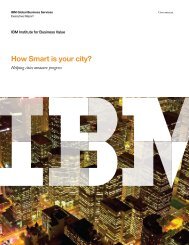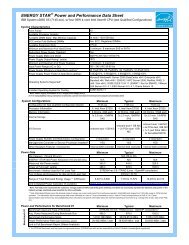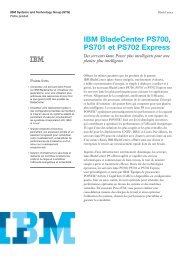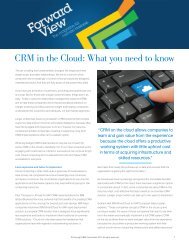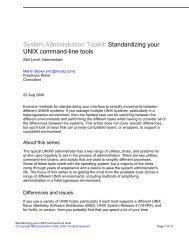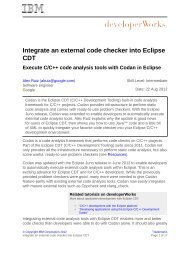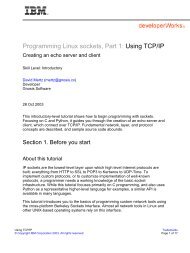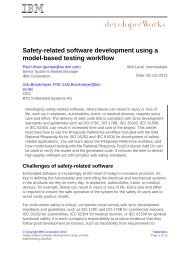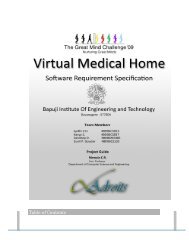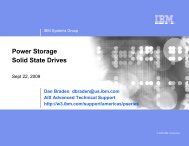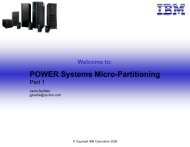TCO for Application Servers: Comparing Linux with Windows and ...
TCO for Application Servers: Comparing Linux with Windows and ...
TCO for Application Servers: Comparing Linux with Windows and ...
You also want an ePaper? Increase the reach of your titles
YUMPU automatically turns print PDFs into web optimized ePapers that Google loves.
<strong>TCO</strong> <strong>for</strong> <strong>Application</strong> <strong>Servers</strong>:<br />
<strong>Comparing</strong> <strong>Linux</strong> <strong>with</strong> <strong>Windows</strong> <strong>and</strong> Solaris<br />
Robert Frances Group<br />
August 2005<br />
IBM sponsored this study <strong>and</strong> analysis. This document exclusively reflects the analysis <strong>and</strong> opinions of<br />
the Robert Frances Group (RFG) author, who has final control of its content.<br />
120 Post Road West, Suite 201<br />
Westport, CT 06880<br />
http://www.rfgonline.com
Executive Summary<br />
Over the past few years, <strong>Linux</strong> adoption rates in the enterprise have soared. Users have quoted a<br />
wide range of <strong>TCO</strong> <strong>and</strong> ROI benefits, <strong>and</strong> <strong>Linux</strong> has become a strategic plat<strong>for</strong>m <strong>for</strong> business<br />
applications at many companies. It has also come under attack by opponents, who have cast doubt<br />
on the cost savings realized by deploying <strong>Linux</strong>.<br />
In an ef<strong>for</strong>t to provide accurate <strong>TCO</strong> data to enterprise IT executives, RFG per<strong>for</strong>med a<br />
quantitative analysis to highlight current operating system experiences in the enterprise. RFG<br />
contacted key buyers <strong>and</strong> IT decision makers across a range of industries, evaluated their level of<br />
satisfaction <strong>with</strong> each operating system, <strong>and</strong> per<strong>for</strong>med a <strong>TCO</strong> analysis incorporating their cost<br />
data. Because it would be difficult, if not impossible, to evaluate every possible application stack<br />
in a single study, RFG examined an application infrastructure layer common to most enterprises –<br />
application servers.<br />
The application server is a critical infrastructure component <strong>for</strong> many companies, <strong>and</strong> thus<br />
represents an ideal target <strong>for</strong> operating system selection. Because the specific workload profile<br />
will have a dramatic impact on the variance in <strong>TCO</strong>, RFG recommends doing any work analysis<br />
this way. IT users should treat <strong>with</strong> skepticism any studies that do not make such workload<br />
distinctions.<br />
RFG has per<strong>for</strong>med several <strong>TCO</strong> studies in the last 3 years, <strong>and</strong> thus has a view into how costs<br />
have shifted as <strong>Linux</strong> adoption rates have increased. As <strong>Linux</strong> has matured, the <strong>TCO</strong> gap between<br />
<strong>Linux</strong> <strong>and</strong> Microsoft <strong>Windows</strong> has narrowed <strong>for</strong> two reasons. First, commercial product vendors<br />
have introduced lower-priced offerings in an attempt to compete <strong>with</strong> <strong>Linux</strong>. Second, <strong>Linux</strong><br />
buyers now treat the plat<strong>for</strong>m as they would a commercial product, purchasing the same support<br />
offerings, management tools, <strong>and</strong> other facilities that they would on any other plat<strong>for</strong>m. Major<br />
vendors now offer a broad array of <strong>Linux</strong> support options, <strong>and</strong> most customers make use of these<br />
offerings. That said, there is still a significant spread between <strong>Linux</strong> <strong>and</strong> the other operating<br />
system choices. Over a three year time frame the overall <strong>TCO</strong> <strong>for</strong> an application server in each<br />
environment is shown below:<br />
Overall <strong>TCO</strong> by Environment<br />
$100,000<br />
$75,000<br />
$50,000<br />
$25,000<br />
$0<br />
$40,149<br />
$67,559<br />
$86,478<br />
<strong>Linux</strong> <strong>Windows</strong> Solaris<br />
<strong>Linux</strong> is 40 percent less expensive than a comparable x86-based <strong>Windows</strong> solution <strong>and</strong> 54<br />
percent less than a comparable SPARC-based Solaris solution, based on a 3-year period of<br />
ownership <strong>for</strong> a system supporting 100,000 operations per second on the SPECjbb® benchmark.<br />
Copyright © 2005 Robert Frances Group, Inc. All rights reserved. 2
In addition, the focus on <strong>Linux</strong> has largely shifted from raw cost factors to a range of financial<br />
<strong>and</strong> other benefits, such as administrator skill portability, hardware architecture portability, <strong>and</strong><br />
vendor diversity. These benefits increase the IT department's ability to quickly <strong>and</strong> costeffectively<br />
meet future workload dem<strong>and</strong>s <strong>and</strong> business challenges.<br />
Beyond <strong>TCO</strong> reductions, study participants quoted a range of financial <strong>and</strong> strategic benefits<br />
realized by deploying <strong>Linux</strong>, including its flexible licensing model, wide range of supported<br />
hardware plat<strong>for</strong>ms, the choice of support providers, <strong>and</strong> fast administrator skill set transfer from<br />
other Unix plat<strong>for</strong>ms. Buyers still appreciate the potential <strong>TCO</strong> reductions <strong>Linux</strong> can yield, <strong>and</strong><br />
this remains an important selection criterion. However, IT decision makers are continually<br />
challenged to make their IT infrastructures more flexible <strong>and</strong> agile. RFG found most participants<br />
eager to capitalize on the long-term strategic benefits <strong>Linux</strong> provides to their organizations.<br />
Key Take<br />
Away <strong>and</strong><br />
Actions<br />
• Executives should consider <strong>Linux</strong> under most circumstances to<br />
support high transaction environments that support scale out or scale<br />
up applications because of the dramatic savings in plat<strong>for</strong>m costs.<br />
• Executives should not be overly concerned that the cost delta will<br />
shrink enough between <strong>Linux</strong> <strong>and</strong> alternative systems to make the<br />
investment in <strong>Linux</strong> questionable over the next 2 to 3 years.<br />
• Executives should feel com<strong>for</strong>table to use cost savings as a basis to<br />
sell a decision to move to <strong>Linux</strong>, but can also identify business<br />
benefits that will in most cases outweigh the cost savings alone of<br />
moving to <strong>Linux</strong> <strong>for</strong> specific solutions.<br />
Methodology<br />
RFG conducted in-depth interviews <strong>with</strong> IT executives involved <strong>with</strong> operating system selection<br />
<strong>and</strong> purchase decisions at over 20 mid-sized to large enterprises (250 employees or more). Study<br />
participants included <strong>Linux</strong>, <strong>Windows</strong>, <strong>and</strong> Solaris users. Although many participants were large<br />
corporations, industry coverage was broad, <strong>and</strong> included education, entertainment, financial,<br />
government, <strong>and</strong> retail, among others.<br />
To provide the most direct comparison possible between the plat<strong>for</strong>m choices, RFG focused on<br />
Java 2 Enterprise Edition (J2EE) application server configurations 1 . RFG evaluated J2EE<br />
environments running on x86-based plat<strong>for</strong>ms running <strong>Linux</strong> <strong>and</strong> Microsoft Corp.'s <strong>Windows</strong>,<br />
<strong>and</strong> Sun Microsystems, Inc.'s SPARC-based plat<strong>for</strong>ms running Solaris. Additionally, RFG<br />
attempted to collect data regarding Solaris on Opteron, but this product combination in<br />
production environments is still relatively new, <strong>and</strong> RFG did not encounter it during the course of<br />
the study.<br />
RFG collected quantitative <strong>and</strong> qualitative data from study participants in the following areas:<br />
• Purchasing, licensing, <strong>and</strong> deployment<br />
• Hardware selection <strong>and</strong> purchase<br />
• Vendor <strong>and</strong> third-party support<br />
• Employee education <strong>and</strong> training<br />
• System per<strong>for</strong>mance <strong>and</strong> application workloads<br />
• System management <strong>and</strong> administration, including security management<br />
1 While Microsoft offers a competing application server technology in .NET, the focus of this study was<br />
on the operating system, not the application server. To avoid confusion, RFG only evaluated cases<br />
where a J2EE product was deployed.<br />
Copyright © 2005 Robert Frances Group, Inc. All rights reserved. 3
RFG has also collected a number of qualitative statements made by the participants during the<br />
course of the study. These statements describe additional benefits or drawbacks, <strong>for</strong> which cost<br />
data is either unavailable or not applicable.<br />
Quantitative Results<br />
The following analysis summarizes the individual cost components <strong>and</strong> the rationale used to<br />
develop them. All analysis is done on a three-year period <strong>with</strong> hardware acquisition costs<br />
included in the first year. Prices were scaled to one Unit of Workload, defined as 100,000<br />
operations per second on the SPEC® Java business application benchmark, SPECjbb®.<br />
The components we use to calculate <strong>TCO</strong> include:<br />
• Hardware Acquisition Costs<br />
• Software License & Maintenance Costs<br />
• OS Support & Systems Administration Costs<br />
• <strong>Application</strong> Server Support & System Administration Costs<br />
Total Cost of Ownership Summary Totals (per Unit of Workload)<br />
$100,000<br />
$80,000<br />
$60,000<br />
$40,000<br />
$20,000<br />
$0<br />
Year 1 Year 2 Year 3 Total<br />
<strong>Linux</strong> $22,642 $8,792 $8,715 $40,149<br />
Solaris $47,026 $19,726 $19,726 $86,478<br />
<strong>Windows</strong> $38,727 $14,416 $14,416 $67,559<br />
The total cost of <strong>Linux</strong> solutions is thus significantly less than either Solaris or <strong>Windows</strong>. The<br />
difference is primarily driven by a mix of lower operating costs <strong>and</strong> capital investment<br />
requirements due to greater processing efficiency <strong>for</strong> the same unit of work.<br />
Hardware Acquisition Costs<br />
Hardware acquisition costs were calculated as follows:<br />
1. The closest matching system was selected from the SPECjbb® database, yielding a<br />
known test configuration <strong>and</strong> its expected per<strong>for</strong>mance.<br />
2. x86-based configurations (or its closest equivalent) were priced <strong>for</strong> purchase from Dell<br />
Inc., Hewlett-Packard Development Company, L.P., <strong>and</strong> IBM Corp., <strong>and</strong> the average<br />
retail price from these vendors' Web sites were used as the system cost. SPARC-based<br />
systems were priced directly from Sun's Web site. Retail pricing was used to eliminate<br />
Copyright © 2005 Robert Frances Group, Inc. All rights reserved. 4
deltas in negotiated discount levels, which were primarily based on participant size <strong>and</strong><br />
negotiating skill, not operating system selection.<br />
3. System costs were scaled to one Unit of Workload.<br />
Hardware costs thus represent the actual system purchase itself, <strong>and</strong> are not amortized or<br />
deferred. Further, system configurations exclude external resources, such as SAN deployments,<br />
firewalls <strong>and</strong> other security devices, <strong>and</strong> network switches. Finally, environmental costs (such as<br />
power) were excluded. <strong>Servers</strong> that can h<strong>and</strong>le a given workload are usually available in a variety<br />
of sizes <strong>and</strong> configurations, <strong>and</strong> this decision is based on available resources <strong>and</strong> business<br />
requirements, not operating system selection.<br />
Hardware Acquisition Costs (per Unit of Workload)<br />
$30,000<br />
$20,000<br />
$10,000<br />
$0<br />
Year 1 Year 2 Year 3 Total<br />
<strong>Linux</strong> $13,191 0 0 $13,191<br />
Solaris $26,816 0 0 $26,816<br />
<strong>Windows</strong> $23,242 0 0 $23,242<br />
RFG was surprised to find such a large gap between the <strong>Linux</strong> <strong>and</strong> <strong>Windows</strong> hardware<br />
acquisition costs. An analysis of the data revealed that study participants drove their <strong>Linux</strong><br />
systems to higher utilization levels than those who used <strong>Windows</strong>, <strong>and</strong> ran more applications on<br />
each server; they there<strong>for</strong>e did not deploy as much excess computing capacity. This allowed<br />
participants to use less expensive systems to support the same workload. IT executives should<br />
include their own utilization levels when per<strong>for</strong>ming this calculation <strong>for</strong> their organizations.<br />
Key Take<br />
Away <strong>and</strong><br />
Actions<br />
For companies <strong>with</strong> capital constraints facing system refresh<br />
decisions, <strong>Linux</strong> can have significant bottom line impact by<br />
supporting both small <strong>and</strong> large workloads on a range of hardware<br />
plat<strong>for</strong>ms, including inexpensive x86-based systems.<br />
Software License <strong>and</strong> Maintenance Costs<br />
Software license <strong>and</strong> maintenance costs were calculated by determining the number of systems<br />
each participant would need to have deployed to provide one Unit of Workload. This server count<br />
(<strong>for</strong> per-server licensing) or the number of processors it represented (<strong>for</strong> per-processor licensing)<br />
was then multiplied by the purchase price of the operating system, JVM, <strong>and</strong> any management<br />
software deployed principally to manage these elements.<br />
The vast majority of the participants chose per-processor licensing <strong>for</strong> their JVM environments.<br />
This produces a delta <strong>for</strong> environments that used fewer systems to support a given workload, as<br />
fewer processors were required, <strong>and</strong> as noted in the hardware section, <strong>Linux</strong> users fall into this<br />
Copyright © 2005 Robert Frances Group, Inc. All rights reserved. 5
category. RFG believes that most companies will look at different software licensing models in<br />
the future, as multi-core processors start to dominate server configurations. <strong>Linux</strong> received a<br />
further benefit because two environments contained an Open Source J2EE server, which removed<br />
one element of cost.<br />
Software License <strong>and</strong> Maintenance Costs (per Unit of Workload)<br />
$60,000<br />
$40,000<br />
$20,000<br />
$0<br />
Year 1 Year 2 Year 3 Total<br />
<strong>Linux</strong> $6,424 $6,424 $6,424 $19,272<br />
Solaris $17,034 $17,034 $17,034 $51,102<br />
<strong>Windows</strong> $12,114 $11,582 $11,582 $35,278<br />
Key Take<br />
Away <strong>and</strong><br />
Actions<br />
<strong>Linux</strong> can reduce on-going licensing <strong>and</strong> maintenance costs,<br />
especially where per-processor licensing models are used. This can<br />
also provide flexibility <strong>for</strong> IT executives examining system<br />
consolidation <strong>and</strong> vertical scaling, reducing the budgetary impact of<br />
that choice.<br />
OS Support Costs<br />
OS Support costs were calculated as follows:<br />
1. The number of administrators responsible <strong>for</strong> the systems involved was determined,<br />
factoring in the percentage of time those administrators spent solely on the systems in<br />
question (<strong>for</strong> example, 20 administrators spending, on average, 10% of their time on the<br />
systems in question was counted as 2 administrators).<br />
2. This count was then multiplied by the ratio of systems deployed to the number of the<br />
participant's systems required to support one Unit of Workload.<br />
3. To adjust <strong>for</strong> regional salary variations, participant salary numbers (including 30%<br />
overhead) were divided by regional salary averages to produce a pay scale ratio <strong>for</strong> each<br />
participant. This ratio was multiplied by national salary averages to produce a normalized<br />
salary figure <strong>for</strong> each company. To this number, RFG added any additional costs, such as<br />
training.<br />
4. Finally, personnel costs were obtained by multiplying the values from steps 2 <strong>and</strong> 3 to<br />
produce a final cost <strong>for</strong> each category.<br />
First year costs include administrator time <strong>and</strong> other one-time costs <strong>for</strong> system deployment, a task<br />
not typically repeated in future years. This study did not examine upgrade costs, because most of<br />
the upgrade cost in a JVM environment is development-related <strong>and</strong> is only minimally impacted<br />
by OS choice or version. Corporate refresh cycles <strong>for</strong> server systems are likely to have a larger<br />
impact, <strong>and</strong> these vary between companies.<br />
Copyright © 2005 Robert Frances Group, Inc. All rights reserved. 6
The primary factors in the low cost of <strong>Linux</strong> were the lower number of systems involved, <strong>and</strong> a<br />
higher number of systems manageable by one administrator. Solaris also had a high ratio of<br />
system to administrators, but this benefit was reduced because more systems were required to<br />
support the same workload. Note that most participants used 1- to 4-CPU systems <strong>for</strong> all three<br />
environments. Vertical scaling would reduce support costs by reducing the number of systems<br />
involved, <strong>and</strong> thus the time spent deploying <strong>and</strong> supporting them.<br />
Key Take<br />
Away <strong>and</strong><br />
Actions<br />
Production results show <strong>Linux</strong> administrators can often manage<br />
more systems that <strong>Windows</strong> administrators in a given amount of<br />
time, resulting in reduced management costs <strong>and</strong> less overall<br />
complexity in management activities.<br />
<strong>Application</strong> Server Support <strong>and</strong> Administration<br />
<strong>Application</strong> server support costs cover management of the JVM environment itself, <strong>and</strong> were<br />
calculated similarly to those <strong>for</strong> the operating system. Most participants employed separate OS<br />
<strong>and</strong> JVM administrators, allowing them to focus employee skill sets <strong>and</strong> training ef<strong>for</strong>ts <strong>for</strong><br />
maximum benefit <strong>and</strong> portability. Where this was not the case, RFG split administrator costs<br />
based on the amount of time each administrator spent on each task. The high cost of <strong>Linux</strong> is<br />
misleading, <strong>and</strong> does not indicate a difficulty in managing JVMs on <strong>Linux</strong>. Instead, while most<br />
participants used separate OS <strong>and</strong> JVM administrators <strong>for</strong> Solaris <strong>and</strong> <strong>Windows</strong> as described<br />
above, this was not yet the case <strong>for</strong> <strong>Linux</strong>. This number is thus a clear example of the productivity<br />
gains possible through specialization of roles <strong>and</strong> responsibilities, a strategic IT move that has<br />
little bearing on the operating system itself.<br />
RFG expects the JVM support cost <strong>for</strong> <strong>Linux</strong> to drop to a level comparable to the other options<br />
once more companies make this change in skill set usage <strong>for</strong> their <strong>Linux</strong> deployments. RFG<br />
believes an increasing number of companies will shift to administrator specialization <strong>for</strong> systems<br />
h<strong>and</strong>ling st<strong>and</strong>ard configuration workloads, as is the case <strong>with</strong> many J2EE server environments.<br />
The architectures of solutions covered in the study fell under two respondent-defined categories:<br />
<strong>Application</strong> Server Support <strong>and</strong> Administration (per Unit of Workload)<br />
$5,000<br />
$4,000<br />
$3,000<br />
$2,000<br />
$1,000<br />
$0<br />
Year 1 Year 2 Year 3 Total<br />
<strong>Linux</strong> $1,559 $1,289 $1,289 $4,137<br />
Solaris $916 $777 $777 $2,470<br />
<strong>Windows</strong> $947 $797 $797 $2,541<br />
Copyright © 2005 Robert Frances Group, Inc. All rights reserved. 7
Key Take<br />
Away <strong>and</strong><br />
Actions<br />
Qualitative Results<br />
IT executives should consider specialization of their <strong>Linux</strong><br />
administrators' roles, as this ef<strong>for</strong>t has proven effective at reducing<br />
management costs on other plat<strong>for</strong>ms, <strong>and</strong> could yield further<br />
savings <strong>for</strong> <strong>Linux</strong> environments.<br />
Most study participants felt that the <strong>TCO</strong> savings realized were sufficient to justify deploying<br />
<strong>Linux</strong> in production. However, when <strong>Linux</strong> <strong>and</strong> other technologies are used to enable strategic<br />
architectural changes, such as server consolidation, vertical scaling, administration process<br />
streamlining, <strong>and</strong> sounder infrastructure engineering, additional benefits may be realized.<br />
Participants shared significant interest in looking beyond a purely <strong>TCO</strong>-oriented view to the longterm<br />
benefits <strong>Linux</strong> could yield. Some of the benefits mentioned include:<br />
• Extensive hardware plat<strong>for</strong>m support – <strong>Linux</strong> may be deployed on a variety of hardware<br />
architectures <strong>with</strong>out significantly changing management processes.<br />
• ISV Support – <strong>Linux</strong> enjoys broad <strong>and</strong> growing ISV support. In conjunction <strong>with</strong> its<br />
extensive hardware plat<strong>for</strong>m support, in many cases this has yielded a greater number of<br />
supported plat<strong>for</strong>m combinations, allowing customers to choose the most appropriate<br />
option to meet each workload requirement.<br />
• Security – Participants reported that it was easier to lock down a <strong>Linux</strong> system <strong>and</strong><br />
deploy patches, <strong>and</strong> that patch deployments produced minimal downtime. These factors<br />
lead to lower security management overhead <strong>and</strong> reduced system downtime.<br />
• Skill set transfer – Because <strong>Linux</strong> is managed similarly to many other Unix plat<strong>for</strong>ms, it<br />
is both an ideal counterpart to those products (allowing administrators to manage both<br />
<strong>Linux</strong> <strong>and</strong> other Unix systems effectively) <strong>and</strong> an ideal replacement <strong>for</strong> them. Moving to<br />
fewer operating systems ultimately reduces support costs <strong>and</strong> improves system to<br />
administrator ratios.<br />
• Vendor diversity – Customers may choose the <strong>Linux</strong> distribution <strong>and</strong> support provider<br />
that is best able to meet their needs. This increases the customer's negotiating power, <strong>and</strong><br />
the variety of licensing <strong>and</strong> support options available allow the customer to choose the<br />
most appropriate options <strong>for</strong> their companies.<br />
RFG attempted to collect data regarding Solaris on Opteron, but this product combination in<br />
production environments is still relatively new, <strong>and</strong> RFG did not encounter it during the course of<br />
the study. Based on early customer feedback, RFG believes the primary selection criteria <strong>for</strong> this<br />
option should be based on strategic considerations rather than <strong>TCO</strong>. IT executives should<br />
evaluate Sun's ability to build an x86 ecosystem, including ISV support, <strong>and</strong> whether this<br />
combination provides business value advantages over other plat<strong>for</strong>ms when evaluating Solaris on<br />
Opteron.<br />
Conclusions<br />
<strong>Linux</strong> provides a lower overall <strong>TCO</strong> compared to <strong>Windows</strong> or Solaris <strong>for</strong> J2EE application server<br />
environments; RFG found <strong>Linux</strong> to be 40 percent less expensive than similarly configured<br />
<strong>Windows</strong> on x86 systems, <strong>and</strong> 54 percent less expensive than Solaris on SPARC. <strong>Linux</strong><br />
competitors have brought costs down over the last few years. However, deltas in support <strong>and</strong><br />
management costs, <strong>and</strong> improvements in how customers manage their <strong>Linux</strong> systems, will likely<br />
allow <strong>Linux</strong> to retain its position as the lowest-cost option. IT executives faced <strong>with</strong> shrinking<br />
Copyright © 2005 Robert Frances Group, Inc. All rights reserved. 8
udgets <strong>and</strong> increasing workloads should thus evaluate <strong>Linux</strong> as an alternative to other operating<br />
system choices.<br />
<strong>Linux</strong> also provides a number of strategic benefits not available in Solaris or <strong>Windows</strong>. It is<br />
available <strong>for</strong> a broad range of hardware plat<strong>for</strong>ms, <strong>and</strong> is cost-competitive when scaled well both<br />
horizontally <strong>and</strong> vertically. Further, it enjoys solid ISV support, <strong>and</strong> is available from a number of<br />
vendors in several licensing <strong>and</strong> support models. <strong>Linux</strong> is thus a flexible plat<strong>for</strong>m <strong>for</strong> enterprise<br />
application workloads, <strong>and</strong> IT executives should explore these aspects to maximize the long-term<br />
value of their <strong>Linux</strong> deployments.<br />
Ultimately, RFG believes IT departments must be extremely agile <strong>and</strong> flexible in order to<br />
successfully meet current <strong>and</strong> future service dem<strong>and</strong>s. Data collected in this <strong>TCO</strong> study shows<br />
<strong>Linux</strong> is not only less expensive, but also provides a range of monetary <strong>and</strong> strategic benefits that<br />
help meet these needs. A move to <strong>Linux</strong> is thus well-aligned <strong>with</strong> these goals, <strong>and</strong> RFG believes<br />
IT executives should seriously evaluate <strong>Linux</strong> <strong>for</strong> their companies' application server workloads.<br />
The work involved in per<strong>for</strong>ming this study was commissioned by IBM Corp. However, the views expressed<br />
herein are those of Robert Frances Group, <strong>and</strong> do not necessarily reflect or represent those of IBM.<br />
Copyright © 2005 Robert Frances Group, Inc. All rights reserved. 9



